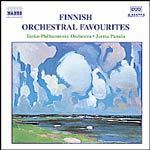
Finnish Orchestral Favourites
 $25.00
Out of Stock
$25.00
Out of Stock6+ weeks add to cart
JARNEFELT / KASKI / SIBELIUS / RAUTAVAARA / MADETOJA
Finnish Orchestral Favourites
Turku Philharmonic Orchestra, Jorma Panula. With Maarit Kirvessalo, violin
[ Naxos / CD ]
Release Date: Tuesday 14 May 2002
This item is currently out of stock. It may take 6 or more weeks to obtain from when you place your order as this is a specialist product.
Composers who have all achieved fame in their native Finland
"The scherzo, marked Allegro molto vivace, has rarely sounded so keenly animated. This is confident music, even exuberant...good sound and an undemanding listen..."
- The Independent (Friday Review) (Rob Cowan) 1st June 2001
There is no doubt that the most famous of all Finnish composers must be Jean Sibelius (1865-1957), a masterly symphonist who captured the spirit and history of his own country in a series of symphonies, tone-poems and other works. Finlandia, in particular, became a symbol of the country's struggle for independence, a cause in which Sibelius was closely involved. It was written in 1899 as part of the music for the press pensions celebration of that year, an event that was transformed into a patriotic demonstration against Russian power. Valse triste, which won widespread popularity in a variety of arrangements but made little money for the composer, was composed in 1903 to accompany a death scene in a play by Sibelius' brother-in-law, Arvid Järnefelt.
Leevi Madetoja (1887-1947) was a pupil of Sibelius in Helsinki and later of Vincent d'Indy in Paris and Robert Fuchs in Vienna. He had a career as a conductor, teacher, critic and composer, and won particular success with his opera Pohjalaisia (The Ostrobothnians), composed in 1923, staged in 1935 and generally regarded as the first significant Finnish contribution to the genre. His Elegy for Strings forms part of his Symphonic Suite, Opus 4, of 1910.
Born in the previous decade, Erkki Melartin (1875-1937) studied in Helsinki and with Fuchs in Vienna, then broadening his education with further travel and study before returning to Finland, where he spent a number of years as director of the Helsinki Music Institute. Like Madetoja, he belongs to the generation of nationalist composers following Sibelius. Prolific as a composer both of lighter and of more serious music, he is widely remembered for his popular Festive March, heard at many Finnish weddings and taken from Melartin's incidental music to the play Prinsessa Ruusunea (Sleeping Beauty). The Wedding March by Toivo Kuula (1883-1918), whose promise as a leading composer in the generation after Sibelius was cut short by his death after the Finnish Civil War, enjoys similar popularity.
Armas Järnefelt (1869-1958), another brother-in-law of Sibelius and a member of a family of distinguished talent and strongly nationalist sympathies, studied with Martin Wegelius and Ferruccio Busoni in Helsinki, in Berlin and then in Paris with Massenet. For a number of years he was principal conductor at the Royal Opera in Stockholm, while as a composer he is chiefly remembered for his Praeludium and Berceuse, the popularity of which has eclipsed other works of his.
Oskar Merikanto (1868-1924) played an important part in Finnish musical life. His numerous piano pieces enjoyed domestic popularity, together with his many songs and he made a significant contribution to the development of church music in Finland and to operatic performance. His Romance and Valse lente have been orchestrated for the present recording by Jorma Panula.
The reputation of Heino Kaski (1885-1957) depends largely on his piano music and one of his best known pieces is his Prelude in G flat major, which he also arranged for orchestra. A composer of another kind is Heikki Aaltoila (1905-1992), who wrote music for 150 plays and more than 75 films. His best known work is his Wedding Waltz of Akseli and Elina, written for Edvin Laine's film Here beneath the North Star. Even better known in Finland must be the Finnish Prayer by Taneli Kusisto (1905-1988), a setting of words by Uuno Kailas, here orchestrated by Jorma Panula.
Einojuhani Rautavaara (1928- ) belongs to a younger generation, a pupil of Merikanto in Helsinki and then of Vincent Persichetti, Aaron Copland and Roger Sessions in America, following this with study in Ascona with Wladimir Vogel and in Cologne with Rudolf Petzold. He has remained open to a wider range of contemporary influences. Fiddlers, Opus 1, was written in 1952 and is derived from folk material.
From a rather earlier generation, Uuno Klami (1900-1961) also represents a move away from romantic nationalism towards a wider spectrum of influences, creating synthesis between Finnish thematic material and stylistic influences from abroad. He studied intermittently, as funds allowed, in Helsinki and then spent a year in Paris, returning to demonstrate a command of orchestration that reflected the influence of Ravel. His Sea Pictures, of which the movement Nocturne (Song of the Watch) is here included, dates from the early 1930s, a reminder of his own early memories of the sea, near which he spent his childhood.
Aulis Sallinen (1935- ) is among the most distinguished of contemporary Finnish composers, significant for his operas as for his contribution to may different genres of music. Sunrise Serenade followed Sallinen's opera Kullervo and is scored for strings, two trumpets and piano, a depiction of the transition from dark to light, a message of optimism.
- Keith Anderson
Tracks:
Sibelius: Finlandia
Madetoja: Elegy for Strings
Merikanto: Romance
Merikanto: Valse lente
Sibelius: Valse triste
Aaltoila: Wedding Waltz of Akseli & Elina
Kaski: Prelude in G flat major
Rautavaara: Fiddlers Op 1
Kuula: Wedding March Op 3 No 2
Melartin: Festive March
Sallinen: Sunrise Serenade
Jarnefelt: Prelude for orchestra
Jarnefelt: Berceuse
Klami: Nocturne (from Sea Pictures)
Kuusisto: Finnish Prayer

